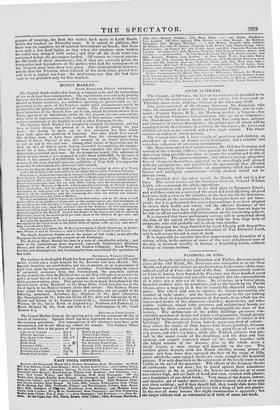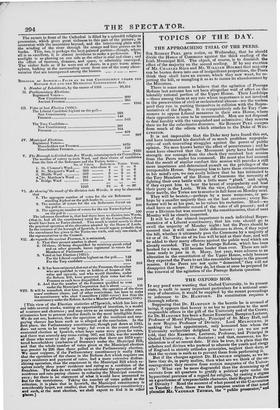PANORAMA OF LIMA.
HAVING formerly carried us to Jerusalem and Thebes, the most ancient cities of the Old World, Mr. BURFORD now transports us to the New World, and places his visiters on an observatory in the centre of the mag- nificent capital of Peru-the land of the Sun. Comparatively modern as Lima is, having been founded by Pizanno just three hundred years ago, it wears so strange and primitive an aspect, that the contemplation of it gives one a new set of ideas. Its situation, on a fertiie plain, bounded on three sides by mountains, and 0:1 the fourth by the Pacific Ocean, gives a majesty to it that its remarkable character nobly sup- ports. The city is laid out in squares, the streets intersecting one another at right angles : and the houses present to the eye looking down on them an irregular pavement of flat roofs, from which rise the towers and domes of the numerous churches, monasteries, and other public buildings, whose lofty greatness and architectural beauty are enhanced by their contrast with the undistinguishable mass of low houses. The architecture of the public buildings possesses con- siderable grandeur of design and justness of proportion, though greatly injured by barbarous ornaments, and the introduction of colours in the buildings. The people of Lima, indeed, seem very fond of colours : they adorn the courts of their houses with fresco paintings, decorate the outer walls with patterns in colours, or paint them all over with red, green, and other e.my hues ; while the Turkish jalousies that pre- vail in the street fronts of the dwellings, and tine flags and rich awnings and carpets scattered about on the roofs, together with the bright colours of tine dresses, give to the whole scene a lively aspect, at once strange and agreeable to the eye. The verdant plains beyond, with the Rimac winding among groves of orange and lime trees that surround the base of the range of hills, above which the snow-capped Andes are seen, complete this beautiful picture. The only drawback to the enjoyment of the lovely scene is not visible to the eye of the spectator. The effects of the frequent shocks of earthquake are not seen ; for, to guard against their calamitous consequences as far as possible, the houses are only one or at most two stories high, and are built of wood and cane, covered with plaster, on a foundation of sun-dried bricks. Very many of the domes, towers, and steeples, are of similar materials : so that a smart shock or so only sets them noddiog ; and if they should fall, they would slide down like the famous tower of Fonthill, and leave but a heap of lath and plaster. In the case of many houses this slight construction is apparent ; but the larger edifices look as substantial as if built of stone and brick. The square in front of the Cathedral is filled by a splendid religiols procession, which gives great richness to this part of the picture; in connexion with the mountains beyond, and the intervening plain with the winding of the river through the orange and lime groves on its banks. This, too, is perhaps the best-painted portion—though, where all is so excellent, it is almost invidious to make a preference. The sunlight is as glowing on one side as the other is cool and clear ; and the effect of vastness, distance, and space, is admirably conveyed. The visiter feels as if he were out of doors, in a pure warm atmo- sphere, looking at the surrounding scene from one of the many obser-
vatories that are interspersed among the houses. . ,



























 Previous page
Previous page